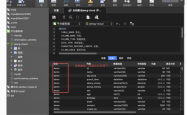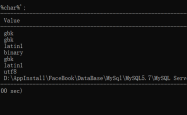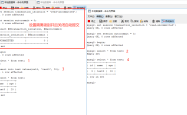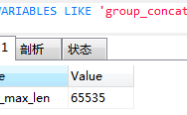mysql查找字符串函数的使用
mysql查找字符串函数
一、根据字符串找位置
-
find_in_set
第二个参数是以逗号隔开的,从第二个参数集合中查找第一个参数的位置
?| 1 2 3 4 5 6 7 | mysql> select find_in_set( 'mysql' , 'oracle,sql server,mysql,db2' ); + ----------------------------------------------------+ | find_in_set( 'mysql' , 'oracle,sql server,mysql,db2' ) | + ----------------------------------------------------+ | 3 | + ----------------------------------------------------+ 1 row in set (0.00 sec) |
-
field
| 1 2 3 4 5 6 7 8 9 10 11 12 13 14 15 16 17 18 | mysql> help field Name : 'FIELD' Description: Syntax: FIELD(str,str1,str2,str3,...) Returns the index (position) of str in the str1, str2, str3, ... list. Returns 0 if str is not found. If all arguments to FIELD() are strings, all arguments are compared as strings. If all arguments are numbers, they are compared as numbers. Otherwise, the arguments are compared as double . If str is NULL , the return value is 0 because NULL fails equality comparison with any value. FIELD() is the complement of ELT(). URL: http://dev.mysql.com/doc/refman/5.5/en/string-functions.html Examples: mysql> SELECT FIELD( 'ej' , 'Hej' , 'ej' , 'Heja' , 'hej' , 'foo' ); -> 2 mysql> SELECT FIELD( 'fo' , 'Hej' , 'ej' , 'Heja' , 'hej' , 'foo' ); -> 0 |
上面两个函数都是全匹配,如下三个函数是子字符串匹配。
?| 1 2 3 | locate(str1,str) position(str1 in str) instr(str,str1) |
这三个函数都是返回参数str中字符串str1的开始位置,注意locate和instr参数的顺序
?| 1 2 3 4 5 6 7 | mysql> select locate( 'sql' , 'mysql' ) locate ,position( 'sql' in 'mysql' ) position ,instr( 'mysql' , 'sql' ) instr; + --------+----------+-------+ | locate | position | instr | + --------+----------+-------+ | 3 | 3 | 3 | + --------+----------+-------+ 1 row in set (0.00 sec) |
二、根据位置找字符串
-
elt(n,str1,str2,…)
elt函数返回指定位置的字符串,项目上如果有这个需求的话,直接使用这个函数还是挺便利的。
?| 1 2 3 4 5 6 7 | mysql> select elt(2, 'huang' , 'bao' , 'kang' ); + -----------------------------+ | elt(2, 'huang' , 'bao' , 'kang' ) | + -----------------------------+ | bao | + -----------------------------+ 1 row in set (0.00 sec) |
-
make_set
相对于elt函数,elt函数只能选择一个具体位置的元素,而make_set则更强大,将换算二进制之后为条件进行选择。1为选择,0不选择。
?| 1 2 3 4 5 6 7 | mysql> select bin(5),make_set(5, 'huang' , 'bao' , 'kang' , 'Love you!' ); + --------+----------------------------------------------+ | bin(5) | make_set(5, 'huang' , 'bao' , 'kang' , 'Love you!' ) | + --------+----------------------------------------------+ | 101 | huang,kang | + --------+----------------------------------------------+ 1 row in set (0.00 sec) |
mysql常用十种字符串函数
1.CONCAT()
CONCAT(str1,str2,…))函数用于返回多个字符串连接之后的字符串,例如:
?| 1 | SELECT CONCAT( 'MySQL' , '字符串' , '函数' ) AS str;str |
输出
MySQL字符串函数
如果该函数中的任何参数为 NULL,返回结果为 NULL。例如:
?| 1 2 3 | SELECT CONCAT( 'MySQL' , NULL , '函数' ) AS str; str | ---+ | |
对于字符串常量,我们也可直接将它们连写在一起。例如:
?| 1 2 3 | SELECT 'MySQL' '字符串' '函数' AS str; str | --------------+MySQL字符串函数| |
以上方式只能用于连接字符串常量,不能用于连接字段的值。
如果启用了 SQL 模式 PIPES_AS_CONCAT,MySQL 逻辑或运算符(||)也可以用于连接字符串,类似于 Oracle 和 PostgreSQL。
除了 CONCAT(str1,str2,…)) 函数之外,CONCAT_WS(separator,str1,str2,…))函数表示使用指定的分隔符 separator 连接多个字符串,分隔符为 NULL 则返回 NULL。例如:
?| 1 2 3 4 | SELECT CONCAT_WS( '-' , 'MySQL' , NULL , '字符串' ) AS str1, CONCAT_WS( NULL , 'MySQL' , '字符串' ) AS str2; str1 |str2 | -----------+----+MySQL-字符串| | |
2.LOWER()
LOWER(str)和LCASE(str)函数用于将字符串转换为小写形式,例如:
?| 1 2 3 | SELECT LOWER ( 'MySQL字符串函数' ) AS str1, LCASE( 'MySQL字符串函数' ) AS str2; str1 |str2 | --------------+--------------+mysql字符串函数|mysql字符串函数| |
MySQL 大小写转换函数不支持二进制字符串(BINARY、VARBINARY、BLOB)),可以将其转换为非二进制的字符串之后再进程处理。例如:
?| 1 2 3 | SELECT LOWER ( BINARY 'MySQL字符串函数' ) AS str1, LOWER ( CONVERT ( BINARY 'MySQL字符串函数' USING utf8mb4)) AS str2; str1 |str2 | -------------------+--------------+MySQLå ç¬¦ä¸²å ½æ °|mysql字符串函数| |
3.UPPER()
UPPER(str)和UCASE(str)函数用于将字符串转换为大写形式,例如:
?| 1 2 3 | SELECT UPPER ( 'MySQL字符串函数' ) AS str1, UCASE( 'MySQL字符串函数' ) AS str2; str1 |str2 | --------------+--------------+MYSQL字符串函数|MYSQL字符串函数| |
4.LENGTH()
LENGTH(str)和OCTET_LENGTH(str)函数用于返回字符串的字节长度,例如:
?| 1 2 3 | SELECT LENGTH( 'MySQL字符串函数' ) AS len1, OCTET_LENGTH( 'MySQL字符串函数' ) AS len2; len1|len2 | ----+----+ 20| 20| |
在 utf8mb4 编码中,一个汉字字符占用 3 个字节。
另外,CHAR_LENGTH(str)和CHARACTER_LENGTH(str)函数用于返回字符串的字符长度,也就是字符个数。例如:
?| 1 2 3 | SELECT CHAR_LENGTH( 'MySQL字符串函数' ) AS len1, CHARACTER_LENGTH( 'MySQL字符串函数' ) AS len2; len1|len2 | ----+----+ 10| 10| |
BIT_LENGTH(str)函数用于返回字符串的比特长度(比特数量),例如:
?| 1 2 3 | SELECT BIT_LENGTH( 'MySQL字符串函数' ) AS len; len | ---+160| |
一个字节包含 8 个比特。
5.SUBSTRING()
SUBSTRING(str,pos)、SUBSTRING(str FROM pos)、SUBSTRING(str,pos,len)以及SUBSTRING(str FROM pos FOR len)函数都可以用于返回从指定位置 pos 开始的子串,len 表示返回子串的长度;pos 为 0 表示返回空字符串。例如:
?| 1 2 | SELECT SUBSTRING ( 'MySQL字符串函数' , 6) AS str1, SUBSTRING ( 'MySQL字符串函数' FROM 6) AS str2, SUBSTRING ( 'MySQL字符串函数' , 6, 3) AS str3, SUBSTRING ( 'MySQL字符串函数' FROM 6 FOR 3) AS str4, SUBSTRING ( 'MySQL字符串函数' , 0) AS str5;str1 | str2 |str3 |str4 |str5 | ---------+---------+-------+------+----+字符串函数|字符串函数|字符串 |字符串 | | |
位置参数 pos 可以为负数,此时返回的子串从字符串右侧第 pos 个字符开始。例如:
?| 1 2 3 | SELECT SUBSTRING ( 'MySQL字符串函数' , -2) AS str1, SUBSTRING ( 'MySQL字符串函数' , -5, 3) AS str2; str1 |str2 | ------+------+函数 |字符串 | |
另外,SUBSTR()和MID()函数都是 SUBSTRING() 函数的同义词,也支持以上 4 种形式。
LEFT(str,len)函数返回字符串 str 左侧的 len 个字符,RIGHT(str,len)函数返回字符串 str 右侧的 len 个字符。例如:
?| 1 2 3 | SELECT LEFT ( 'MySQL字符串函数' ,5) AS str1, RIGHT ( 'MySQL字符串函数' ,5) AS str2; str1 |str2 | -----+---------+MySQL|字符串函数| |
SUBSTRING_INDEX(str,delim,count)函数返回第 count 个分隔符 delim 之前的子串。如果 count 为正数,从左侧开始计数并返回左侧的所有字符;如果 count 为负数,从右侧开始计数并返回右侧的所有字符。例
如:
?| 1 2 3 | SELECT SUBSTRING_INDEX( '张三;李四;王五' , ';' , 2) AS str1, SUBSTRING_INDEX( '张三;李四;王五' , ';' , -2) AS str2; str1 |str2 | --------+--------+张三;李四|李四;王五| |
6.TRIM()
TRIM([remstr FROM] str)函数用于返回删除字符串 str 两侧所有 remstr 字符串之后的子串,remstr 默认为空格。例如:
?| 1 2 3 | SELECT TRIM( ' MySQL字符串函数 ' ) AS str1, TRIM( '-' FROM '--MySQL字符串函数--' ) AS str2; str1 |str2 | --------------+--------------+MySQL字符串函数|MySQL字符串函数| |
TRIM([{BOTH | LEADING | TRAILING} [remstr] FROM] str)函数用于返回删除字符串 str 两侧/左侧/右侧所有 remstr 字符串之后的子串,默认删除两侧字符串(BOTH),remstr 默认为空格。例如:
?| 1 2 3 | SELECT TRIM(LEADING ' ' FROM ' MySQL字符串函数 ' ) AS str1, TRIM(TRAILING '-' FROM '--MySQL字符串函数--' ) AS str2; str1 |str2 | ----------------+----------------+MySQL字符串函数 |--MySQL字符串函数| |
7.LPAD()/RPAD()
LPAD(str,len,padstr)函数表示字符串 str 的左侧使用 padstr 进行填充,直到长度为 len;RPAD(str,len,padstr)函数表示在字符串 str 的右侧使用 padstr 进行填充,直到长度为 len。例如:
?| 1 2 3 | SELECT LPAD(123, 6, '0' ) AS str1, LPAD(123, 2, '0' ) AS str2, RPAD(123, 6, '0' ) AS str1, RPAD(123, 2, '0' ) AS str1; str1 |str2|str1 |str1 | ------+----+------+----+000123|12 |123000|12 | |
当字符串 str 的长度大于 len 时,相当于从右侧截断字符串。
另外,REPEAT(str,count)函数用于将字符串 str 复制 count 次并返回结果。例如:
?| 1 2 3 | SELECT REPEAT( '' , 5) AS str; str | ----------+| |
8.INSTR()
INSTR(str,substr)函数用于返回子串 substr 在字符串 str 中第一次出现的索引位置,没有找到子串时返回 0。例如:
?| 1 2 | select INSTR( 'MySQL字符串函数' , '字符串' ) AS index1, INSTR( 'MySQL字符串函数' , '日期' ) AS index2, INSTR( 'MySQL字符串函数' , '' ) AS index3, INSTR( 'MySQL字符串函数' , null ) AS index4;index1|index2|index3|index4 | ------+------+------+------+ 6| 0| 1| | |
另外,LOCATE(substr,str)函数也可以用于返回子串 substr 在字符串 str 中第一次出现的索引位置,和 INSTR(str,substr) 函数唯一的不同就是参数的顺序相反。
LOCATE(substr,str,pos)函数返回子串 substr 在字符串 str 中从位置 pos 开始第一次出现的索引位置,例如:
?| 1 2 3 | SELECT LOCATE( 'S' , 'MySQL Server' , 5) AS ind; ind | ---+ 7| |
FIELD(str,str1,str2,str3,…) 函数返回字符串 str 在后续字符串列表中出现的位置,没有找到时返回 0。例如:
?| 1 2 3 | SELECT FIELD( '李四' , '张三' , '李四' , '王五' ) AS ind; ind | ---+ 2| |
FIND_IN_SET(str,strlist) 函数返回字符串 str 在列表字符串 strlist 中出现的位置,strlist 由 N 个子串使用逗号分隔组成。例如:
?| 1 2 3 | SELECT FIND_IN_SET( '李四' , '张三,李四,王五' ) AS ind; ind | ---+ 2| |
9.REPLACE()
REPLACE(str,from_str,to_str)函数用于将字符串 str 中所有的 from_str 替换为 to_str,返回替换后的字符串。例如:
?| 1 2 3 | SELECT REPLACE ( 'MySQL字符串函数' , '字符串' , '日期' ) AS str1, REPLACE ( 'MySQL字符串函数' , '字符串' , '' ) AS str2; str1 |str2 | ------------+---------+MySQL日期函数|MySQL函数| |
另外,INSERT(str,pos,len,newstr)函数用于在字符串 str 的指定位置 pos 之后插入子串 newstr,替换随后的 len 个字符。例如:
?| 1 2 3 | SELECT INSERT ( 'MySQL字符串函数' , 6, 3, '日期' ) AS str; str | ------------+MySQL日期函数| |
10.REVERSE()
REVERSE(str)函数用于将字符串 str 中的字符顺序进行反转。例如:
?| 1 2 3 | SELECT REVERSE( '上海自来水来自海上' )= '上海自来水来自海上' AS "回文" ; 回文 | ----+ 1| |
以上为个人经验,希望能给大家一个参考,也希望大家多多支持服务器之家。
原文链接:https://blog.csdn.net/huangbaokang/article/details/97264469
1.本站遵循行业规范,任何转载的稿件都会明确标注作者和来源;2.本站的原创文章,请转载时务必注明文章作者和来源,不尊重原创的行为我们将追究责任;3.作者投稿可能会经我们编辑修改或补充。










